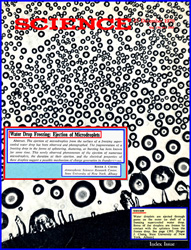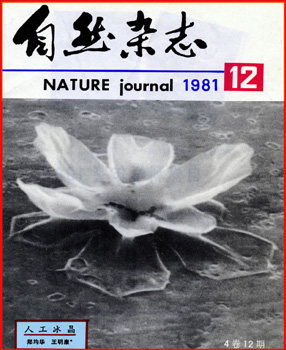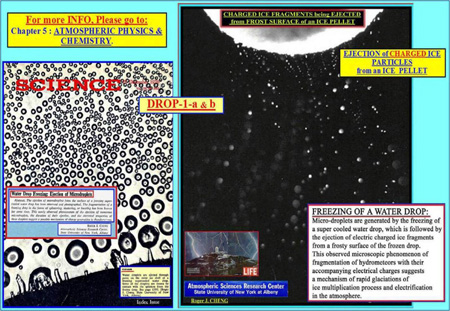
|
STAGE-TWO
|
 |

-
CITATION: ELECTRICAL EFFECTS
-
that may HAPPEN in ICE CLOUD-in 3-stages
|
The exact mechanism of thunderstorm electrification and the glaciations processes in ice clouds that lead up to it. Remain elusive. Earlier this year Monitor reported some work showing how freezing super cooled drops eject tiny positively charged droplets to produce primary electric charge separation (see New Scientist. viol 49. p 54-1970), Roger J. Cheng who discovered this effect, and his colleague Vincent Schemer at the State University of New York. Have now pointed out some related effects in the growth of ice crystals which may account for the observed very rapid glaciations process that typifies certain types of super cooled concessive clouds (Journal de Recherché Atmosphéngues. vol V. no I.-1971). Such clouds often cause thunderstorms and blizzards. In the laboratory it is possible to generate the kind of small ice crystals seen in Figure d, which closely resemble those found by sampling actual clouds of this type, by forming a layer of frost on a cold piece of ice. Schaefer and Cheng say the effect can be demonstrated by putting some dry ice into a polythene bag and sticking the bag in warm air. The bag soon becomes coated with a dust-like frost layer which grows and eventually sprouts minute tree-like growths of ice crystals. Under a low-power microscope these particles arc seen to be intensely mobile, twisting and writing, breaking off from the surface, and sometimes exploding into masses of even smaller fragments. the photograph shows, the ice particles are often very tenuously attached to the surface. It seems obvious that their motions must be a response to static electrical forces. The two cloud physicists propose that a similar mechanism is at work on the surfaces of hailstones which form in Convective clouds at an early stage when there are plenty of droplets and moisture for their growth. As they get larger they fall into regions of warmer air which, if it is super-saturated. Coats them with a delicate layer of frost. The disintegration of the frost particles leads to further nuclei for the development of new ice crystals. Thus providing a chain reaction of glaciations. Figure C shows an experimental hailstone-in a moist environment repelling frost particles electrically from ice dendrites. Under the microscope the ice particles can be seen to move vigorously in response to an electrically charged object. The stems” of the ‘trees” are, in many cases, very thin (often less than five micrometers) that they would be expected to evaporate easily, adding to the fragility of this frost layer. And. In fact, Schaefer and Cheng have observed progressive thinning of the particle’s attachments in this manner. Cheng recently wrote to Monitor pointing out that their team has now determined that the ejected ice particles from frosty surfaces mostly carry negative electrical charges. Presumably leaving the surface in question with a net positive charge. Once a basic charge-separation mechanism of this kind has been proven it becomes possible to suggest means by which larger and smaller components are physically separated and thus build up the high voltages characteristic of thunder clouds. It appears that protons travel more easily through ice and tend to congregate at the colder parts. In Cheng’s earlier experiment the warmer water droplets were positively charged and the residual freezing parent drop negatively charged. On disintegrating frosty surfaces this situation is apparently reversed. Another later discovery is that ejected ice fragments certainly can be grown to produce perfect ice crystals. |
|
.jpg) |
 |
 |
 |
 |
 |
 |
|
|
HOME
|
ATMOSPHERIC
SCIENCES
|
SNOW
and ICE
CLOUD
SEEDING
|
FREEZING
of A WATER DROP
|
FRAGMENTATION
of
A FROZEN DROP
|
MELTING
of
A
FROZEN DROP
|
CHARGE
within
An
ICE CRYSTAL
|
PUBLICATION
and
CITATION
|








